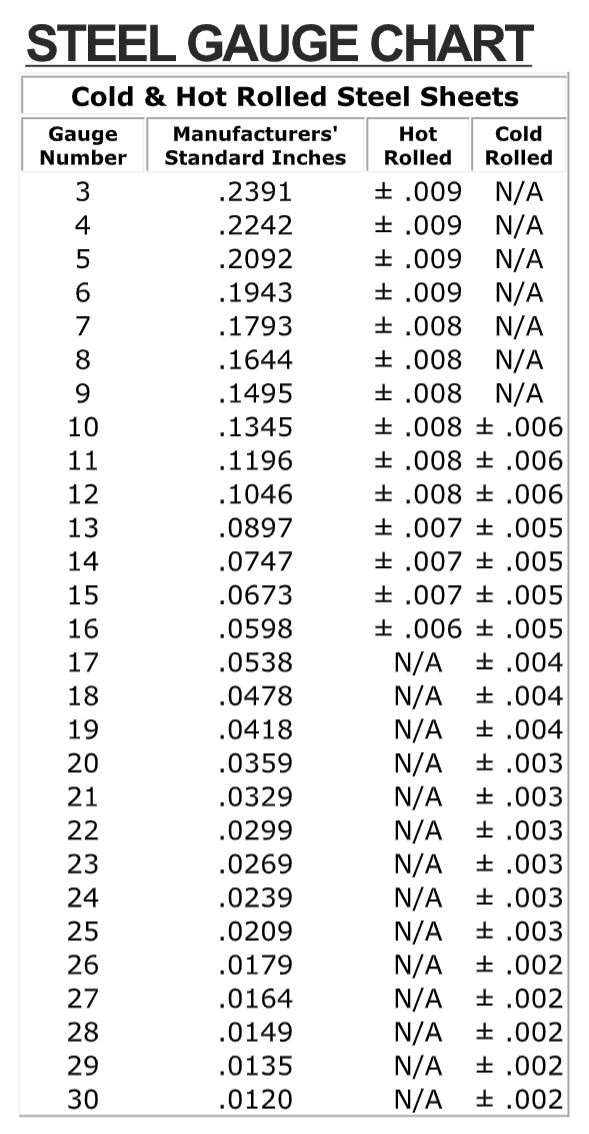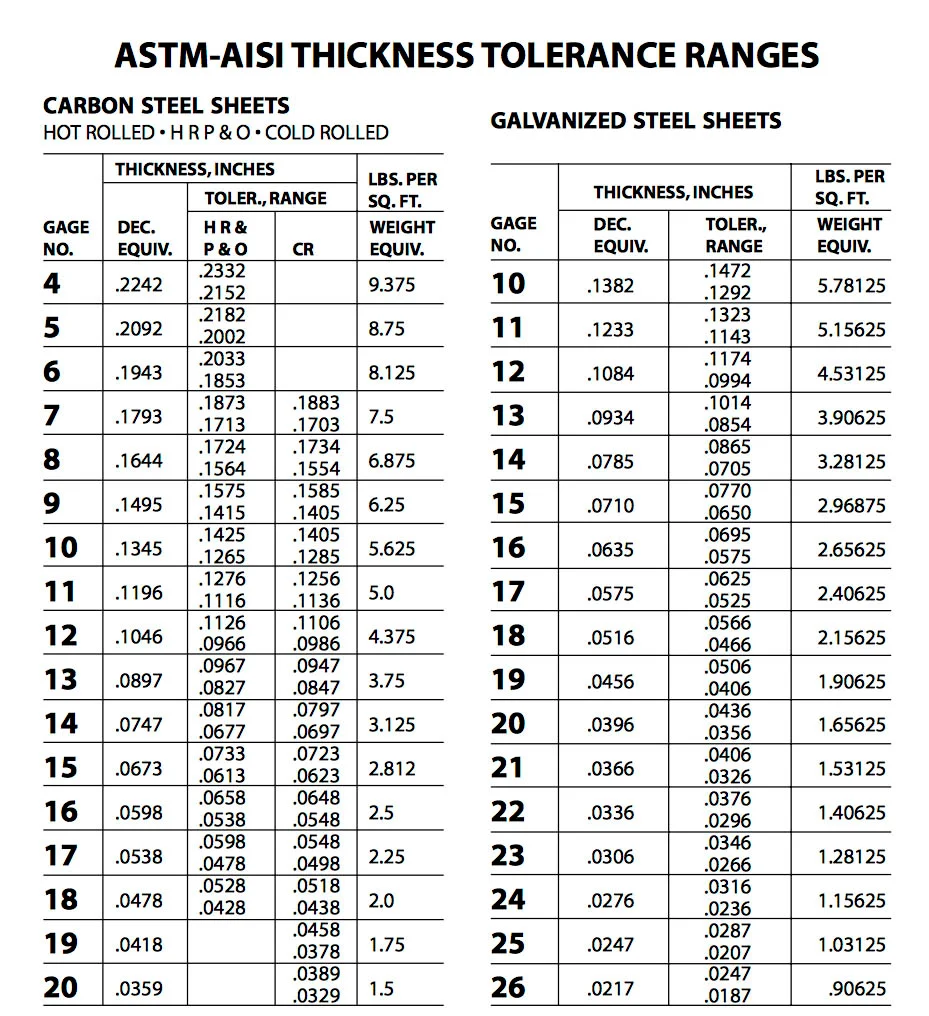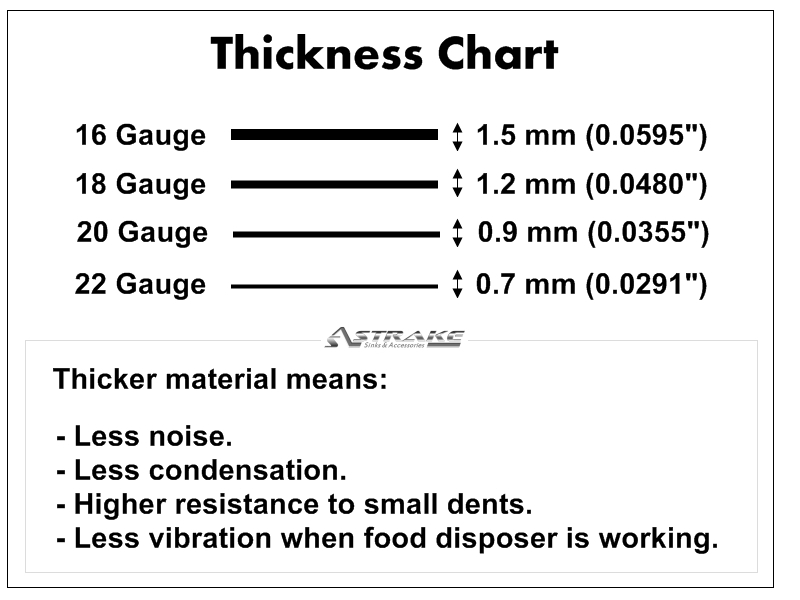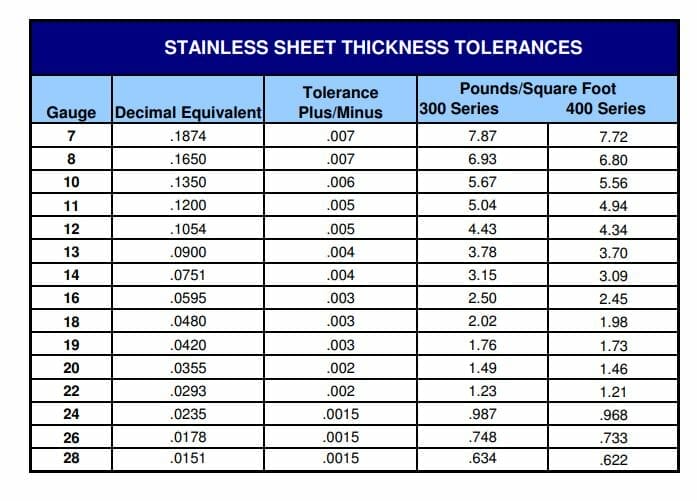16 Gauge Sheet Metal Thickness - The weight per unit area. 0.0595 (1.511) 0.0635 (1.61) 0.0598 (1.52) 0.0508 (1.29) 15. Gauge are used to specify the thickness of a metal sheet. When working with sheet metal, the term “gauge” is often used. The chart below can be used to determine the equivalent sheet thickness, in inches or millimeters, for a gauge number from the selected gauge size standard. The higher the gauge, the thinner the. Gauge to thickness chart (click here for a printable pdf chart) gauge. The following sheet metal gauge size reference chart gives the weight and thickness of sheet metal given as a gauge (sometimes spelled gage) and indicates the standard thickness of. A sheet metal gauge chart uses the thickness and weight per area of different metals to determine standardised thicknesses or ‘gauges’. Gauge (ga.) is a length.
0.0595 (1.511) 0.0635 (1.61) 0.0598 (1.52) 0.0508 (1.29) 15. The higher the gauge, the thinner the. The chart below can be used to determine the equivalent sheet thickness, in inches or millimeters, for a gauge number from the selected gauge size standard. The following sheet metal gauge size reference chart gives the weight and thickness of sheet metal given as a gauge (sometimes spelled gage) and indicates the standard thickness of. Gauge (ga.) is a length. A sheet metal gauge chart uses the thickness and weight per area of different metals to determine standardised thicknesses or ‘gauges’. What is 16 gauge thickness in mm? When working with sheet metal, the term “gauge” is often used. Gauge to thickness chart (click here for a printable pdf chart) gauge. The weight per unit area.
When working with sheet metal, the term “gauge” is often used. The higher the gauge, the thinner the. What is 16 gauge thickness in mm? 0.0595 (1.511) 0.0635 (1.61) 0.0598 (1.52) 0.0508 (1.29) 15. The chart below can be used to determine the equivalent sheet thickness, in inches or millimeters, for a gauge number from the selected gauge size standard. The weight per unit area. A sheet metal gauge chart uses the thickness and weight per area of different metals to determine standardised thicknesses or ‘gauges’. Gauge are used to specify the thickness of a metal sheet. The following sheet metal gauge size reference chart gives the weight and thickness of sheet metal given as a gauge (sometimes spelled gage) and indicates the standard thickness of. Gauge to thickness chart (click here for a printable pdf chart) gauge.
16 Gauge Sheet Metal Thickness In Mm
Gauge to thickness chart (click here for a printable pdf chart) gauge. Gauge (ga.) is a length. The following sheet metal gauge size reference chart gives the weight and thickness of sheet metal given as a gauge (sometimes spelled gage) and indicates the standard thickness of. A sheet metal gauge chart uses the thickness and weight per area of different.
Sheet Metal 16 Gauge Thickness
A sheet metal gauge chart uses the thickness and weight per area of different metals to determine standardised thicknesses or ‘gauges’. The weight per unit area. Gauge are used to specify the thickness of a metal sheet. The following sheet metal gauge size reference chart gives the weight and thickness of sheet metal given as a gauge (sometimes spelled gage).
16 Gauge Sheet Metal Thickness In Mm
What is 16 gauge thickness in mm? The following sheet metal gauge size reference chart gives the weight and thickness of sheet metal given as a gauge (sometimes spelled gage) and indicates the standard thickness of. A sheet metal gauge chart uses the thickness and weight per area of different metals to determine standardised thicknesses or ‘gauges’. 0.0595 (1.511) 0.0635.
Sheet Metal Gauge Thickness Conversion Chart
What is 16 gauge thickness in mm? The weight per unit area. A sheet metal gauge chart uses the thickness and weight per area of different metals to determine standardised thicknesses or ‘gauges’. Gauge (ga.) is a length. The chart below can be used to determine the equivalent sheet thickness, in inches or millimeters, for a gauge number from the.
Steel sheet metal gauge chart MS/ carbon steel thicknesses
When working with sheet metal, the term “gauge” is often used. 0.0595 (1.511) 0.0635 (1.61) 0.0598 (1.52) 0.0508 (1.29) 15. The weight per unit area. Gauge (ga.) is a length. The higher the gauge, the thinner the.
How Thick Is 16 Gauge Stainless Steel
0.0595 (1.511) 0.0635 (1.61) 0.0598 (1.52) 0.0508 (1.29) 15. Gauge to thickness chart (click here for a printable pdf chart) gauge. What is 16 gauge thickness in mm? The higher the gauge, the thinner the. The chart below can be used to determine the equivalent sheet thickness, in inches or millimeters, for a gauge number from the selected gauge size.
Steel Gauge Chart MD Metals
When working with sheet metal, the term “gauge” is often used. Gauge (ga.) is a length. What is 16 gauge thickness in mm? The following sheet metal gauge size reference chart gives the weight and thickness of sheet metal given as a gauge (sometimes spelled gage) and indicates the standard thickness of. 0.0595 (1.511) 0.0635 (1.61) 0.0598 (1.52) 0.0508 (1.29).
How Thick Is 16 Gauge Aluminum Sheet
0.0595 (1.511) 0.0635 (1.61) 0.0598 (1.52) 0.0508 (1.29) 15. The higher the gauge, the thinner the. When working with sheet metal, the term “gauge” is often used. The weight per unit area. What is 16 gauge thickness in mm?
How Thick Is 16 Gauge Steel Sheet
Gauge are used to specify the thickness of a metal sheet. Gauge (ga.) is a length. 0.0595 (1.511) 0.0635 (1.61) 0.0598 (1.52) 0.0508 (1.29) 15. Gauge to thickness chart (click here for a printable pdf chart) gauge. The chart below can be used to determine the equivalent sheet thickness, in inches or millimeters, for a gauge number from the selected.
Sheet Metal Gauge Chart Metal Supermarkets
Gauge are used to specify the thickness of a metal sheet. A sheet metal gauge chart uses the thickness and weight per area of different metals to determine standardised thicknesses or ‘gauges’. The following sheet metal gauge size reference chart gives the weight and thickness of sheet metal given as a gauge (sometimes spelled gage) and indicates the standard thickness.
What Is 16 Gauge Thickness In Mm?
The following sheet metal gauge size reference chart gives the weight and thickness of sheet metal given as a gauge (sometimes spelled gage) and indicates the standard thickness of. Gauge (ga.) is a length. The weight per unit area. The higher the gauge, the thinner the.
Gauge To Thickness Chart (Click Here For A Printable Pdf Chart) Gauge.
The chart below can be used to determine the equivalent sheet thickness, in inches or millimeters, for a gauge number from the selected gauge size standard. When working with sheet metal, the term “gauge” is often used. Gauge are used to specify the thickness of a metal sheet. A sheet metal gauge chart uses the thickness and weight per area of different metals to determine standardised thicknesses or ‘gauges’.









